Table of Contents
ToggleCarbide Metal Cutting Circular Saw Blades
When it comes to cutting metal, choosing the right tool is crucial for achieving precise, clean results. Among the various options available, carbide metal cutting circular saw blades have emerged as a preferred choice for professionals and DIY enthusiasts alike. Understanding their benefits and applications can help you make an informed decision when purchasing these essential tools.
The Advantages of Carbide Metal Cutting Circular Saw Blades
Carbide metal cutting circular saw blades are engineered for exceptional durability and performance. One of the primary benefits of these blades is their ability to withstand high temperatures generated during the cutting process. This thermal stability means that the blades retain their sharpness longer than traditional steel blades, reducing the need for frequent replacements. For example, when cutting through stainless steel or hard metals such as aluminum, carbide blades can maintain their edge well, leading to cleaner cuts and less friction.
Another significant advantage of carbide blades is their versatility. They are suitable for various applications, from cutting steel and aluminum to working with copper and brass. Whether you’re fabricating metal parts for an industrial project or completing a home improvement task, a carbide metal cutting circular saw blade can handle the job with ease.
Superior Performance in Different Applications
To fully appreciate the value of carbide metal cutting circular saw blades, consider their application in various fields. In construction, for instance, workers often encounter metal rods, sheets, or tubes. Using a carbide blade allows them to achieve precise cuts without bending or warping the material, which is essential for structural integrity.
Moreover, in automotive applications, mechanics frequently cut metal components to size. A carbide blade makes this process quicker and simpler, allowing for high-speed cutting that saves valuable time. For instance, when working on exhaust systems or chassis modifications, precision is key, and a carbide blade enables mechanics to cut accurately without generating excessive heat or sparks.
Cost-Efficiency Over Time
While carbide metal cutting circular saw blades may have a higher upfront cost compared to conventional steel blades, they prove to be a cost-effective solution in the long run. The extended lifespan and reduced need for replacements not only save money but also time spent on tool maintenance. When calculating the overall investment, the benefits of durability and performance clearly outweigh the initial price tag.
Customers often inquire about the longevity of these blades, especially when making bulk purchases for workshops or construction sites. Carpentry or metal fabrication businesses can significantly reduce operating costs by investing in quality carbide blades. Regular users will find that by using high-performance carbide blades, they won’t need to change blades as frequently, allowing for uninterrupted workflows.
The Importance of Choosing the Right Blade
Selecting the correct carbide metal cutting circular saw blade is vital for optimal performance. Blade sizes, tooth counts, and designs vary greatly depending on the material being cut and the type of cut required. For example, blades with fewer teeth are ideal for swift cuts through thicker materials, while those with more teeth are designed to achieve cleaner, finer finishes on thinner metals.
Additionally, compatibility with different saws is crucial. Not all circular saws can handle carbide blades, so it’s essential to ensure that your saw is rated for such high-performance tools. Reading product descriptions and manufacturer guidelines will help clarify whether a specific carbide metal cutting circular saw blade is suitable for your saw model.
Real-World Examples
Consider a metal fabrication shop that relies heavily on carbide metal cutting circular saw blades. When producing custom parts for machinery, precision is non-negotiable. Staff there use a blade with a higher tooth count for intricate cuts, ensuring that each piece fits perfectly in larger assemblies. On the other hand, when cutting rough stock to prepare for further processing, they switch to a blade with fewer teeth to maximize efficiency. This adaptability showcases how selecting the right carbide blade can enhance productivity without sacrificing quality.
Another example arises in home renovation projects. A DIY enthusiast may need to cut steel tubing for a project like building a custom railing. By investing in a carbide metal cutting circular saw blade, they can achieve clean cuts, which not only enhance the final product’s appearance but also support safety and structural integrity.
Maintaining Your Carbide Metal Cutting Circular Saw Blade
To maximize the lifespan of your carbide metal cutting circular saw blade, appropriate maintenance is essential. Cleaning the blade after use can prevent the build-up of debris and grime, which can dull the cutting edge over time. It’s also advisable to check the blade for any signs of wear or damage after extensive use. If minor chips are discovered, professional sharpening services can restore the blade’s performance.
Proper storage is another vital aspect of maintenance. When not in use, blades should be kept dry and free from any contact that can lead to dings or bends. Using protective cases or blade guards will not only keep the blade in good shape but also ensure safety during storage.
Conclusion
In conclusion, a carbide metal cutting circular saw blade represents a smart investment for anyone working with metal, whether in a professional setting or at home. With impeccable durability, versatility, and cost-efficiency, these blades provide the performance needed for a variety of tasks. By understanding how to select, use, and maintain these tools effectively, you’re setting yourself up for success in any metalworking endeavor.
As you venture into your next project involving metal, remember the pivotal role of choosing the right blade. A carbide metal cutting circular saw blade can be the difference between a job well done and a frustrating experience, making your tool selection an essential part of your project planning.
